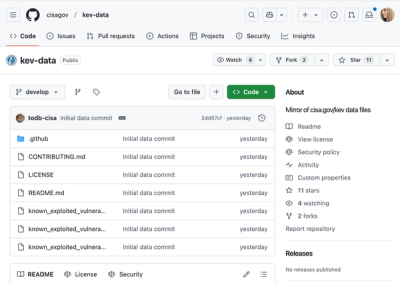
Security News
CISA Brings KEV Data to GitHub
CISA's KEV data is now on GitHub, offering easier access, API integration, commit history tracking, and automated updates for security teams and researchers.
emp-chromecast-receiver-2-dev
Advanced tools

This document provides an overview of building a custom Google Cast receiver application. https://developers.google.com/cast/docs/custom_receiver. Your custom receiver application has to be deployed to a web server with a domain name and SSL support. The url to the receiver application has to be registered at Google, with a company account owning the streaming services. https://developers.google.com/cast/docs/registration Google Cast SDK Developer Console https://cast.google.com/u/2/publish/#/overview
The receiver is compliant with the default chromecast receiver API unless otherwise stated. For information on how to build a sender and other additional functionalities see https://developers.google.com/cast/docs/sender_apps
Hosted Demo receiverAppId E5A43176 (private)
A demo receiver app that uses this package is available here
As a developer you need to add custom ui-logic to the receiver-app and customize the index.html file. To build the code there are a few requirements
Unix-based systems
sudo npm install -g grunt-cli
Windows
npm install -g grunt-cli
to setup your project
npm install
to build a local copy of the receiver
grunt build
pull update from emp-chromecast-receiver-2 npm package. (will overwrite images, css, index.html and emp-receiver-app.js)
grunt update
then deploy the dist directory in any webserver, add the webserver-URL in Google Cast SDK Developer Console and enjoy!
Some grunt tasks are available:
grunt
grunt build
Builds the code and and places the final app in the dist folder.
grunt deploy
An example on how to use ftp to send the app to a webserver. If the ftp server requires authentication, credentials should be placed in a .ftpauth file in the root of the project
Javascript for the receiver is written using the new ES6 standard. Using grunt tasks this is then re-written into the ES5 standard. To learn more about Es6 see babel. To keep our code clean and separated, we uses Browserify. This allows us to use require statements to import javascript code from other files.
All of the above is done automatically using the grunt build system, but during development one should be aware of the power, and the limitations of both systems.
The receiver has separated ui-logic and playback-logic. emp-receiver playback-logic is installed from a npm package. Run npm install to get all depending npm packages. As a developer you need to add custom ui-logic to the receiver-app and customize the index.html file. Receiver-app should implement an event listener for METADATA_UPDATED: fired when a program change occurs, should be used to display title and images about the current program. STATE_CHANGED: fired when playback state has changed, should be used to display a play icon, buffer spinner etc. emp-receiver exposes the inner emp-player, other playback events can be handled directly on the emp-player. Receiver-app.js and index.html are samples of how to implement a custom emp-receiver.
Note: Slow embedded devices like Chromecast version 1 have problem to start casting with big bundle javascript, link script separately in index.html like this instead:
<script type="text/javascript" src="//www.gstatic.com/cast/sdk/libs/receiver/2.0.0/cast_receiver.js"></script>
<script type="text/javascript" src="//www.gstatic.com/cast/sdk/libs/mediaplayer/1.0.0/media_player.js"></script>
<script type="text/javascript" src="js/video.min.js"></script>
<script type="text/javascript" src="js/emp-player.min.js"></script>
<script type="text/javascript" src="js/emp-shaka.min.js"></script>
<script type="text/javascript" src="js/emp-receiver-your-app.min.js"></script>
emp-player options can be send to empReceiver constructor and emp-player events can be subscribed to.
let options = {
debug: false,
playerOptions: {
empshaka: {
abr: {
// startBitrate 5Mbps
defaultBandwidthEstimate: 5e6
}
}
}
};
this.empReceiver_ = new empReceiver(player, options, () => {
this.empReceiver_.player.on(empPlayer.Events.PLAYING, this.onPlayStateChange_.bind(this));
this.empReceiver_.player.on(empPlayer.Events.PAUSE, this.onPlayStateChange_.bind(this));
this.empReceiver_.player.on(empPlayer.Events.SEEKING, this.onPlayStateChange_.bind(this));
this.empReceiver_.player.on(empPlayer.Events.WAITING, this.onPlayStateChange_.bind(this));
this.empReceiver_.player.on(empPlayer.Events.ENDED, this.onPlayStateChange_.bind(this));
this.empReceiver_.player.on(empPlayer.Events.ERROR, this.onPlayStateChange_.bind(this));
});
The receiver makes use of emp-player version 2.
FAQs
EMP Receiver v2
The npm package emp-chromecast-receiver-2-dev receives a total of 168 weekly downloads. As such, emp-chromecast-receiver-2-dev popularity was classified as not popular.
We found that emp-chromecast-receiver-2-dev demonstrated a not healthy version release cadence and project activity because the last version was released a year ago. It has 1 open source maintainer collaborating on the project.
Did you know?

Socket for GitHub automatically highlights issues in each pull request and monitors the health of all your open source dependencies. Discover the contents of your packages and block harmful activity before you install or update your dependencies.

Security News
CISA's KEV data is now on GitHub, offering easier access, API integration, commit history tracking, and automated updates for security teams and researchers.

Security News
Opengrep forks Semgrep to preserve open source SAST in response to controversial licensing changes.

Security News
Critics call the Node.js EOL CVE a misuse of the system, sparking debate over CVE standards and the growing noise in vulnerability databases.